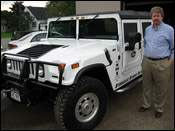James A. O'Brien II is behind the wheel of a bright yellow Volkswagen Beetle putt-putting around the parking lot of the Deerfield Fire Department.
The little car has a Frankenstein-like power plant jutting from its rear - a 6.5-horsepower engine taken from a log-splitter and a couple of hydraulic accumulators, shiny columns that protrude beyond where the VW's engine hood once was.
The little engine is hammering away, pushing the car at several few miles per hour. "Now I'll show you something you can't do in a conventional vehicle," Mr. O'Brien says.
Suddenly, he cuts off the engine.
But the car keeps moving forward, silently.
Welcome to the world of Hybra-Drive Systems, a fledgling firm that might revolutionize the concept of hybrid vehicles.
Instead of the traditional electric-gasoline hybrid that's familiar to most consumers, Mr. O'Brien's company is perfecting a more efficient form of propulsion by harnessing age-old hydraulic technology. "Six years ago it occurred to me that electric propulsion probably isn't the right way to build a hybrid," he says.
Mr. O'Brien, 43, of LaSalle, has an electrical engineering degree and experience working in various industries.
"Hybrid technology has nothing to do with engine technology," he explains. "It's really about maximizing tank-to-tire efficiency. The energy is really in the fuel."
The Beetle was just an experiment, not much different that the seventh-grade science project that first piqued Mr. O'Brien's interest in hydraulic drive systems.
Now, in the lot of his non-descript Deerfield headquarters, a Humvee H1 represents the next generation of research and development.
Unlike the Beetle, it looks no different from the outside than a stock Humvee. But beneath the hood and under the frame are the guts of a hydraulic hybrid system that can soup up the Humvee's performance as if it was on steroids.
"We haven't added to the weight, and it has more torque and performance than it had before," Mr. O'Brien says. He's also more than doubled the miles per gallon. "It has better fuel economy than a small pick-up truck," he boasts.
With better torque, it accelerates better and can climb hills faster.
So it might not be surprising that Hybra-Drive got a visit from U.S. Army TACOM officials.
"TACOM heard we were working on it and they called us," Mr. O'Brien says. "The military seems to see value in what we're doing."
"The Army's main goal is giving the soldiers the ability to get out of harm's way quickly," he says.
The Army has given Hybra-Drive its first big contract. The company also created another hydraulic-drive Humvee for Gates, the maker of drive-belts, as part of a cooperative research and development agreement. "We believe we're the first company that's actually sold a hydraulic hybrid to another company," Mr. O'Brien says.
Hybra-Drive's prototypes have set industry shows abuzz, and Mr. O'Brien says his 4-year-old firm is on the verge of taking off. He predicts his handful of employees will blossom to more than 50 within a year and to 300 shortly afterward.
He says the advantages to hydraulics are clear. They boost mileage more than electric batteries, don't involve the weight and toxins of batteries, and aren't as susceptible to cold-weather ills. The hydraulic systems are virtually maintenance-free and the hydraulic oil he uses is fully biodegradable, drawn from plant matter.
He sees the first applications of the technology in fleets that do a lot of heavy-hauling and starting and stopping, such as UPS or FedEx. "We have very strong commercial opportunities," he says. "The only question is how fast can we commercialize it."
Eventually, possibly within three years, he sees the technology being used in more traditional vehicles, such as bigger pick-ups or sport-utility vehicles. "Why buy small cars when big cars can be fuel efficient, too?" he asks .

